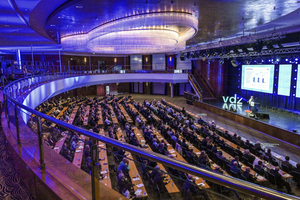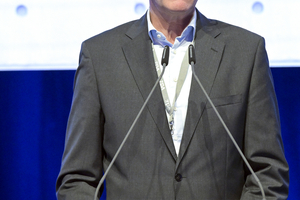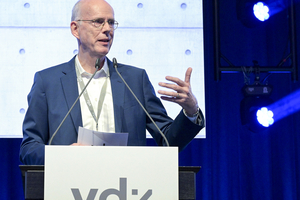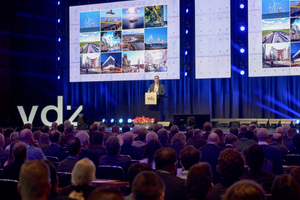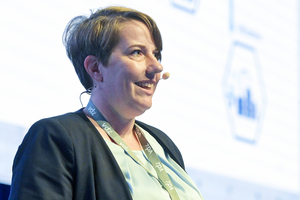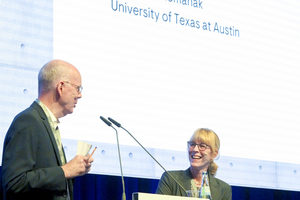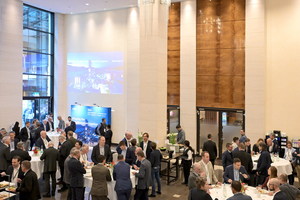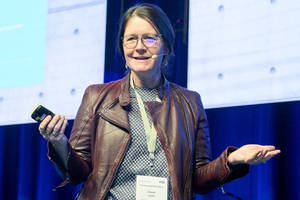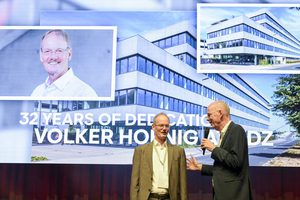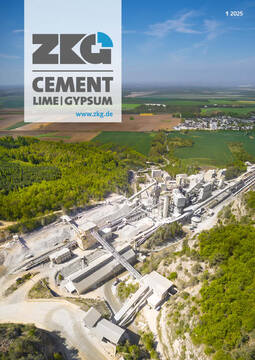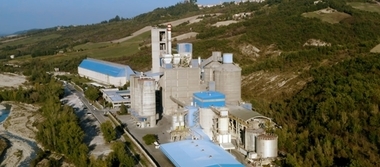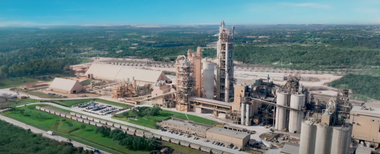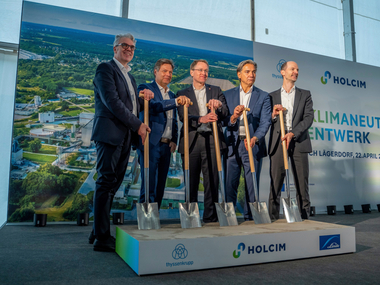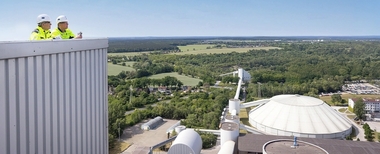German Cement Works Association (VDZ) 9th International Congress: Decarbonization, digitalization and energy efficiency were key topics
The now 9th International VDZ Congress took place from November 6 - 8, 2024 in Düsseldorf at the Maritim Hotel at the airport. The congress provides a scientific platform for cement manufacturers, research specialists, associations and experts from the cement plant construction industry to exchange ideas. A total of around 650 participants came to discuss topics such as decarbonization through carbon capture or optimization of the manufacturing process, digitalization to increase efficiency or process control. Not least due to the VDZ roadmap and that of the other international cement associations, the cement industry has set itself very specific goals with regard to the topic of decarbonization. This means that completely new technical solutions will have to be developed and the cement industry is facing a historic turning point. These challenges were also clearly reflected in the congress program.
On November 6, 2024, Christian Knell, President of the German Cement Works Association (VDZ), officially opened the 9th International VDZ Congress: “The cement and concrete industry is probably undergoing the biggest transformation in its history. Step by step, we are decarbonizing our value chain,” emphasized the VDZ President. “There is no alternative, we have to achieve a net-zero value chain for cement and concrete, and we will succeed if we get the right framework conditions and the support of politicians and society.” He emphasized the importance of joint exchange and cooperation in order to create a sustainable industry and achieve the net-zero target by 2040/2045.
The global demand for cement and concrete remains high, and large-scale construction is unthinkable without these materials. “Cement and concrete are needed, and it is up to us to decarbonize them,” said Martin Schneider, Managing Director of VDZ. “Our sector will be part of a bigger solution. We will continue to contribute to global prosperity while achieving net zero and resource efficiency in our processes and in the value chain.”
After Paul Astle from Ramboll had discussed “The decarbonization of concrete design” by reducing the use of primary concrete (e.g. by reusing concrete elements) or by using concrete with lower CO2 emissions, Hendrik Möller from Schwenk gave a very comprehensive presentation on “The Role of SCM in tomorrow’s cement and concrete”. Möller listed the SCMs currently in use as well as those with future potential. A whole series of start-ups are currently working on the reactivity and usability of SCMs, taking into account the chemical properties and the availability of corresponding industrial by-products. He also explained the role and possible areas of application as well as the advantages and disadvantages of blended and remediated SCMs. Finally, the speaker discussed the variety of possible SCMs, but also the challenges that arise on the factory side with the use of SCMs.
“Do we really recycle concrete?” asked Jan Skocek from Heidelberg Materials in his presentation “Closing the material and CO2 loop of concrete”, focusing primarily on the aspects of the circular economy in the construction materials industry, specifically concrete. Instead of traditional recycling, selective separation is the method of choice for processing old concrete. There are many different processes that can be used to achieve the required separation, e.g. with high-voltage pulses or thermal processes. Studies have shown that recycled aggregates and sand do not impact compressive strength. Heidelberg Materials thus wrote a success story: The Ekocem selective separation plant was commissioned April 2024 and the first industrial reactor for the enforced carbonation is being built and is expected to be commissioned in January 2025.
The presentation by Karl-Heinz Boes, Holcim, and Stefan Seemann, VDZ, “Grinding - state of the art and challenges”, focused on the challenges posed by reducing the proportion of clinker in favor of other mineral components. It is not only the clinker substitutes that place high demands on the grinding process, but also the high electricity prices and targets regarding a CO2-neutral cement process. In the second part of the paper, the VDZ Separate Grinding Study was presented, in which the separate ultra-fine grinding concept was presented and the specific energy requirements for this were examined.
The afternoon program ended with the lecture “Carbon Capture Process Chain”, presented by Dr Kristina Fleiger, VDZ. Various technologies for capturing and storing CO2 are already at the test stage. The presentation gave a comprehensive overview of the methods, their limitations and financing options. Clinker production must also be considered, for example in order to produce combustion air with the highest possible CO2 content. This is followed by the steps of capture, purification/conditioning, storage and utilization. In all these steps, the technical conditions must be analyzed, the best options selected and the technical possibilities for implementation examined. Dr Kristina Fleiger went into all of this in detail in her presentation.
CCS: indispensable for achieving climate targets
The morning of the second day of the VDZ Congress 2024 was all about carbon capture technologies, ongoing projects and technologies on the way to net zero cement production. Katherine Romanak, Gulf Coast Carbon Center & Bureau of Economic Geology at the University of Austin/Texas, began by shedding light on “The Role of CCS” - and emphasized that, unfortunately and incorrectly, carbon capture & storage often suffers from an “image problem” in the public eye: CCS supports the fossil fuel industry, is an unsafe technology with no proven benefits and is not economically viable - from a scientific point of view, however, these prejudices are not tenable.
Without the use of CCS, according to Romanak, neither the global climate targets can be achieved, nor can the path to net zero cement production be taken. CCS is by no means a new technology, so according to the author, the procedure is safe and effective, risks are low and manageable - and for effective use, Carbon Capture and Storage would have to be used a hundred times more by 2050.
The safety of CCS has been clearly demonstrated in over 25 years of research. In the process, CO2 is injected into the pore space at depths of > 800 m via boreholes, captured using various methods such as structural separation, dissolution or mineralization and stored in the pores for thousands of years, where its safety continues to increase over time. An interesting analogy from the speaker: “Imagine a sandwich on which you spread mayonnaise. Afterwards, you realize that you don‘t actually want mayonnaise, but no matter how hard you try, it has already soaked into the pores and will stay there.” CO2 storage projects such as Sleipner, Snohvit (both in Norway), Weyburn (Saskatchewan/Canada) and SACROC (Texas/USA), some of which have been running for decades and are closely monitored, demonstrate the safety of the process.
To demonstrate the safety of CCS, Romanak went into some specific aspects:
Assessment of metal mobilization: metal mobilization in drinking water is temporary and recedes on its own over time, he said. In most cases, these metals do not rise above drinking water standards
Terrestrial ecosystem: Effects here are spatially limited, as plants and microbes can absorb considerable amounts of CO2 and develop into acid-tolerant species
Marine ecosystem: Air bubbles dissolve within 10 m above the seabed; Dissolved CO2 sinks to create a plume near the seabed; Many species have mechanisms to protect from small pH fluctuations
There has been a massive increase in CCS projects in the cement industry in particular: There are 30 CCS projects in Europe, North America and China with a combined capacity of 29 Mt/a. The largest facility for CO2 storage is currently located in Qingzhou/China with a capacity of 200 kt/a, but the facility currently under construction at the Brevik cement plant in Norway is expected to have a capacity of 400 kt/a.
Holcim: From Adsorption to Oxyfuel
Under the title “Experiences from Carbon Capture Projects at Holcim”, Dr.-Ing. Michael Weihrauch presented several ongoing projects on the subject of CCU/CCS and emphasized: “CCUS will have to be widely applied to achieve Net Zero.” Currently, the use of these technologies only accounts for a small fraction of the reduction in CO2 emissions, but the aim is to increase this to 44% by 2050 in order to achieve net zero CO2 emissions.
There are always three aspects to consider when developing carbon capture projects:
Plant integration: Condition for clinker production; energy demand (electrical/thermal); water demand; space
Technology: Technology watch and selection; pilot projects
Value chain: Transport, sequestration, usage
With regard to the use of electrical energy and water in CCUS projects, Weihrauch summarizes: “A high mean time between failures (MTBF) and net availability are key elements for electricity saving and the reuse of condense water is important for water consumption.” Electricity consumption in the cement plant increases by a factor of 2-4, with 70-80% of electrical energy consumption required for the operation or start-up of the carbon capturing unit. Waste water recovery and efficient cooling systems could only partially compensate for the higher water requirement.
Holcim and other partners in the industry are currently working on over 80 separation processes. Weihrauch provided a brief overview of four of the processes:
Höver/Germany: Membrane Membrane material uses the different permeability of gases to separate CO2; in the pilot project, < 1 t/d could be separated
Richmond/Canada: Adsorption CO2 is adsorbed on a porous surface and desorbed by changing temperature; < 1 t/d could be separated in the pilot project
Volos/Greece: Amine absorption CO2 is absorbed in a solvent (amines) and desorbed at higher temperature; 2.5 t/d could be captured in the pilot project
Gladstone/Australia: Potassium carbonate absorption CO2 is absorbed in a solvent (potassium carbonate) and desorbed at higher temperature; 20 t/d were captured in the pilot project
6 of Holcim’s research projects on CCUS had also received grants from the EU Innovation Fund, the speaker presented a brief overview of the respective processes and results:
Carbon2Business (Lägerdorf/Germany): Pure oxyfuel Capture of 1.2 Mt/a CO2
Go4ECOPlanet (Kujawy/Poland): Adsorption Capture of 1.2 Mt/a CO2
GO4ZERO (Obourg/Belgium): Oxyfuel switchable Capture of 1.1 Mt/a CO2
KOdeCO (Koromacˇno/Croatia): Adsorption Capture of 0.4 Mt/a CO2
eM Rhône (Le Teil/France): Adsorption capture of 0.2 Mt/a CO2, utilization as E-methanol
Olympus (Milaki/Greece): Oxygen enriched separate line calciner Capture of 1.0 Mt/a CO2
Pure Oxyfuel: The catch4climate project
Heidelberg Materials, Dyckerhoff, Schwenk, Vicat - these four partners from the European cement industry are part of the “Cement Innovation For Climate (CI4C)” initiative. Tobias Kaschke spoke at the VDZ about the value of cooperation on the way to climate neutrality in the industry and presented “The catch4climate-project - the first of its kind Pure Oxyfuel pilot plant”. The project envisages that the oxyfuel furnace plant in Mergelstetten/Germany will go into operation in the first quarter of 2025, the project was already launched on December 6, 2019.
In the oxyfuel clinker burner process, the speaker explained, pure oxygen is fed into the furnace instead of air in order to ensure that heat is generated without atmospheric nitrogen. This increases the proportion of CO2 in the flue gas in the furnace to around 90% and thus achieves a considerably higher capture potential.
In his presentation, Kaschke explained that various hurdles had to be overcome for the correct application of the oxyfuel process:
Use of oxygen and CO2-rich inert gas in different areas of the plant: Separator required to control oxygen supply via the clinker cooler; sources of false air must be reduced; dust load in the preheater; fuel supply in the calciner
Handling of Liquified Oxygen (LOX): storage of huge amounts of liquid oxygen; handling of cryogenic liquids; supply chain / logistics; Requirements for Air Separation Uni (ASU) operator (peak quantities)
Carbon Purification Unit (CPU): Completely new for the cement world; handling of cryogenic liquid, NH3 cooling system Dealing with new technology requires new training concepts; Stable and high CO2 concentration at the battery limit as a key requirement for the CPU performance & fluctuation of impurities
Due to this multitude of challenges, holistic approaches to mitigate the risks are required, covering process safety, safety in the cement plant and the general organization of health and safety. The CI4C project brought together 50 people from three different cement manufacturers for an intensive training of about 9 months to deal with the correct application of the new technology.
According to Kaschke, the first results of the catch4climate project are expected in 2026 - although it is assumed that the know-how phase could take several more years.
Process development and digitalization
The interesting morning session was followed by parallel lecture sessions. On Thursday afternoon, the topics “Decarbonization through process development” and “Digitalization to increase efficiencies” were on the agenda. Claude Lorea from the Global Cement and Concrete Association (GCCA) presented the GCCA’s roadmap and analysed both the status quo of the global cement industry‘s decarbonization efforts and the further measures required to achieve the goals set out in the roadmap. Global cooperation and a good network are particularly conducive to this. In the last few years alone, 10 new members have joined the GCCA. “GCCA members account for 80% of the global cement industry volume outside of China - and include several leading Chinese manufacturers,” stated Lorea.
The following presentation gave a comprehensive overview of the current state of the art and the global efforts to reduce CO2 and their goals, e.g. in the form of roadmaps. In “Vision on Future Cement Plant”, Sui Tonbo from Sinoma focused on the importance of a holistic approach. In particular, he highlighted the possibilities of using alternative binders to support the reduction targets.
Alternative binders were also the subject of the next two presentations. In “Meca clay, a promising alternative technology to activate any clay as SCM” by Dr Luc Rudowski, thyssenkrupp Polysius, he presented a breakthrough in clay activation with a new process. The meca clay is created by mechano-chemical activation, with the help of dry agitated bead mill technology, defects are introduced into the material structure to achieve reactivity. This was followed by an extensive characterization of the meca clay. The presentation by Avet François, Vicat, dealt with the industrial production of calcined clay as well as the long-standing tradition of using calcined clays, for example in Brazil, where the first production took place in the 1960s.
CO2 reduction through the use of ultrafine grinding technology for SCM - this was the starting point for the presentation by Nestor Isaias Quintero Mora and Yuly Natalia Cajamarca from Cemex. Many tests and investigations on this promising path have already been presented in the lecture. Now it is time to complete the industrialization tests and search for industrial partners for technology boost.
AI & Data: Digitalisation to increase efficiencies in the industry
The afternoon session “Digitalization to increase efficiencies” on 7 November 2024 took a closer look at digital approaches to support the (cement) industry. Four topics were presented:
In “Digital transformation - unifying data structures in cement plants”, Kevin Treiber (VDZ) emphasized, “AI, data driven and machine learning applications require available, accessible and reliable data.” To ensure access to this data, a VDZ working group has developed a data management strategy. The daily use of data is increasing, which is why an interconnected availability of metadata and a connection of assets in different views is required. A machine-readable structure and metadata, historical plant information linked directly to process data and defined system boundaries enable easier implementation of applications. In addition, automation is required for data integration.
In the presentation “Cement plant maintenance and process optimization”, Scott Ziegler, CEO of cemAI, emphasized that the use of AI and prescriptive maintenance could reduce downtime in the cement plant, improve technical reliability and optimize processes, which would result in significant cost savings. By using cemAI, for example, the improvements in the reliability factor are between 3% and 12%. In one year, a plant with 7% RE increase documented an avoidance of 268 h of kiln downtime and an avoidance of $ 270000 maintenance costs.
In “Enhancing efficiency – standardizing delivery notes in the cement industry to meet evolving supply chain demands”, Wolfgang Peseke (Dyckerhoff) stated: “There is no standard for electronical delivery notes and for the exchange between the building materials industry and the construction sector.” However, since the building materials industry operates the platforms for customers and the construction industry – willing to exchange data with the suppliers – is starting their own digital activities, one interface is needed as a common solution. Huge enterprises will not use different customer platforms since they need a peer-to-peer connectivity to order materials. Peseke concluded: “If we don’t find a common standard and approach to support the supply chain process, other proxies/platforms will offer these services, and we can lose the control of our data and processes. Let’s find an easy approach for our industries.”
During the presentation “AI in Action: Improving kiln stability and fuel efficiency with artificial intelligence”, Dr Daniel Summerbell (CarbonRe) stated: “AI models can utilise more available plant data than traditional APC.” According to the speaker, cloud computing enables regular model updates to maintain performance and the integration of a closed loop approach ensures near-real time optimisations 24/7. As a best practice example, Dr Summerbell and Jiri Strapina, manager at the Heidelberg Materials Mokra plant, presented the implementation of CarbonRe’s technology at the Mokra plant.
VDZ: Honoring Volker Hoenig
During the evening event, Volker Hoenig, who retired after more than 30 years at VDZ, was honored. “We would like to thank Volker, an outstanding technical expert, a colleague who was always ready to help and a friend who was always there for us - for more than 30 years of service to VDZ,” emphasized Dr Martin Schneider.
Process control and binder technology
Day three of the conference started again with parallel sessions. This time the topics were “Process control - emission abatement” and “Binder technology - existing and new concepts”. The inherent concern of all presentations was the production of low-CO2 cements.
Process control – Emission abatement
The morning parallel session “Process Control – Emission Abatement” on the last day of the 9th International VDZ congress put in focus topics such as generational changes in the cement industry, electrification – and “Unicorn hunting”.
In “Successful generational change at Alpacem Austria”, Florian Salzer (Alpacem) took a look at the company’s history in relation to technical innovations that have been implemented throughout the last 30 years. “How did we achieve this?”, the speaker asked in the middle of his presentation – and gave away the answer: “Through generational change”. While the average age over the last three decades always remained under 40 years, 47% of the company’s current employees completed their apprenticeship at Alpacem. Also the success is to be observed by taking a look at the improvement of production parameters throughout the last ten years.
Speaking about “Mercury emissions – control and measurement”, Robin Harrass and Ute Zunzer (both VDZ) concluded: “Dust shuttling in mill-off operations at low filter temperatures is the first step when it comes to the control and measurement of mercury emissions.” This method is proven and systematically applied in many cement plants already. As part of the process-integrated thermal desorption, mercury reduction and additional energy demand have to be weighed carefully. Due to that, solutions must be implemented individually for each kiln system and the continuous monitoring of Hg is essential in order to monitor all possible plant conditions.
In “Electrification of the clinker manufacturing process”, Albrecht Schall (VDZ) compared electro thermal heating to hydrogen production with electricity. When it comes to electro thermal heating there is not sufficient operating time in kilns to draw real conclusions, according to the speaker. The plasma torch can be operated inside a preheater kiln, however, there is presently not enough research done on plasma burners. Taking a look at the hydrogen production with electricity; “it will take a long time until hydrogen will be available for the cement industry”, said Schall. As of today it will be cost prohibitive to use hydrogen in the cement industry, so relying on hydrogen as a mean to reduce CO2 is not a good option in the opinion of the speaker.
During the presentation “Unicorn hunting – how to attract and keep talents for our industry”, Stefan Puntke (Refratechnik) shared some ideas on what has to be adjusted in nowaday’s industry in order to attract newcomers/talent. He stated: “Culture eats any strategy for breakfast!” In his opinion, initiatives to attract and keep talents might be 1.) checking your company culture, 2.) updating your job requirements, 3.) investing in digital tools, 4.) making training and development the company’s biggest priority and 5.) revising your marketing and advertising
strategy.
In the final presentation of the session, “Retrofitting of a pot calciner – impact on thermal efficiency and CO₂ emissions”, Martin Oerter (Dyckerhoff) presented the results of retrofitting the calciner kiln 8 at the Lengerich cement plant. The results after one and a half years: The temperature of the combustion chamber is manageable, less fuel is drawn in cyclones 5 and 6, leading to less cyclone blockages, and up until now, low coating-formation behaviour can be observed (14 additional shock blowers were installed). Additionally, there is less ammonia water consumption and a lower NH3-slip, a homogenisation of exhaust gas temperatures in cyclone 1 A and B took place and an overall more stable kiln operation can be observed.
Binder technology - existing and new concepts
The session “Binder technology” was opened by Aproov Sinha from Carbon Upcycling. “Unlocking a new generation of SCMs” characterizes the focus of the presentation very well. Industrial byproducts such as CCPs, clays, stell slags or natural pozzolans are to be prepared with different activation steps so that low-CO2 cement can be produced.
“Co-reactive - turning captured CO2 into pozzolanic material”, presented by Orlando Kleineberg, Andreas Bremen and Ahmed Kalifa, Co-reactive, presented a patent-pending CO2 mineralization process which turns CO2 into a carbon-negative supplementary cementitious material (SCM). The advantage of this process is the availability of the raw materials, the scalability, carbon uptake, pozzolanic reactivity (> 20% of amorphous SiO2, that acts as a pozzolan in cement and concrete), circular economy and strength (comparable with the strength at 91 d as a CEMI mortar).
Further binder systems were also presented in the following papers. The final presentation was given by Simone Schulze from VDZ with the lecture “Calcined clays of different origin - their performance as SCM in cement”. This presentation focused primarily on the available qualities of the available clays and the performance of calcined clays as clinker substitutes in cement/concrete. There are sufficient resources available: About 26% of the near-surface rocks are shales or clays and about 15 Mio. t/a clay-containing waste material from pit and quarry industry in Germany.
Thus ended three interesting days full of valuable technical information and fruitful exchanges.

